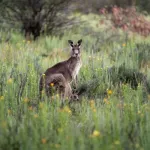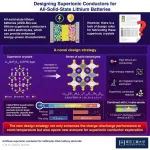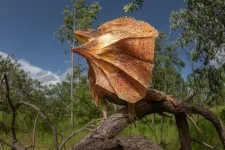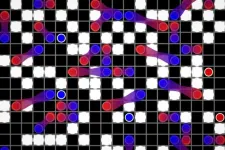(Press-News.org) How temperate and boreal trees’ leaves respond to climate change remains uncertain. Now, a new study of northern forests reports that while early-season climate warming – that occurring before the summer solstice – tends to be associated with earlier autumn leaf senescence, late-season warming (after the summer solstice) has the opposite impact, delaying onset of leaf senescence in fall. “Improved models of plant development and growth under climate change will need to incorporate the reversal of warming effects after the summer solstice,” write Constantin Zohner and colleagues, authors of the study. Climate change has resulted in changes to the growing seasons of plants. For example, research shows that the start of the growing season for boreal and temperate trees – when leaves emerge during the spring and trees begin to photosynthesize – occurs, on average, two weeks earlier than it did during the 19th and 20th centuries. Similarly, the end of season (EOS) – when autumn leaves die and fall – is being delayed. Not only do these shifts affect tree performance, but they can also lead to changes in ecosystem structure and functioning, impacting global biogeochemical cycles. A longer growing season could mean greater carbon sequestration in forests, for example. The timing of EOS largely depends on dynamic environmental and biological interactions, which aren’t well understood. Using a combination of satellite, ground, carbon flux, and experimental data, Zohner and colleagues evaluated how leaf senescence relates to various environmental cues, including day length, temperature, and early-season photosynthesis, across northern forests. Across 84% of the study area, Zohner et al. found that warming had opposing effects on leaf senescence depending on when the warming occurred. According to the findings, increased temperatures and leaf growth before the summer solstice was correlated with earlier onset of leaf senescence by a rate of roughly 2 days per degree Celsius (°C) of warming. Warmer temperatures following the solstice delayed autumn leaf senescence by ~2.5 days per °C. “The solstice switch in trees’ physiological responsiveness to temperature calibrates their seasonal rhythms and mediates how they react to warm or cool temperatures, now and in the future,” say the authors.
For reporters interested in trends, a 2020 Science study reporting results of a large-scale analysis of European trees reported that climate warming was causing tree leaves to fall earlier in autumn. The results were built on growing evidence that plant growth is limited by the ability of tree tissues to use and store carbon.
END
The solstice switch: Warming’s effects on autumn leaf senescence depend on timing
2023-07-06
ELSE PRESS RELEASES FROM THIS DATE:
Two studies report: Perovskite-silicon tandem cells that break the 30% efficiency threshold
2023-07-06
In two separate studies, researchers present novel methods that enable the fabrication of high-performance perovskite-silicon tandem solar cells with power conversion efficiencies exceeding 30%. Silicon solar cells – the most commonly deployed photovoltaic (PV) technology – are rapidly approaching their theoretical power conversion efficiency (PCE) limit of 29%. One way to increase the efficiency of a solar cell is to optimize the spectrum of sunlight for conversion into energy. This can be done by stacking two or more interconnected photoactive materials into a singular device, improving ...
Precipitation tolerance helped explain which vertebrate species spread between newly joined continents
2023-07-06
A new study helps explain why rates of species exchange are at least twice as high from west to east than in the opposite direction across Wallace’s Line. The study included an analysis of more than 20,000 species belonging to all 227 families of terrestrial vertebrates present in the Indo-Australian archipelago. As tectonic plates merge, once disparate continents can connect and create new opportunities for biotic exchange. Species movement across newly connected continents millions of years ago continues to shape assemblages of flora and fauna today. One of the most well-known ...
Ready for its close-up: The electron’s permanent electric dipole moment
2023-07-06
A new study with direct implications for one of the most important unresolved questions in physics – the imbalance of matter and antimatter in our universe – reports “the most precise measurement yet” of the size of the electron’s permanent electric dipole moment. The imbalance between matter and antimatter in the Universe can be explained via the breaking of charge parity symmetry. The standard model (SM) of particle physics predicts a slight breaking of this symmetry, but it is insufficient to explain the imbalance actually observed. Many extensions to the standard ...
Policymakers should consider animal welfare in decisions
2023-07-06
Incorporating animal welfare into policymaking may improve policy and practice, according to Rutgers research.
The article, published in Science, notes that animal welfare rarely is considered during policymaking, explains why current tools make it difficult to incorporate the well-being of animals into public policy and identifies methods for remedying these issues.
“Animal welfare is often ignored in policymaking, despite its relevance across many domains ranging from food systems to biomedical research to climate policy,” said Mark ...
Why you won’t see kangaroos in Java but you will find goannas in Australia
2023-07-06
Ask anyone what first springs to mind when they think of Australia and they’ll most likely say a kangaroo; the marsupial is ingrained in our national identity. But have you ever wondered why kangaroos never ventured beyond our shores?
A major study led by biologists at The Australian National University (ANU) and ETH Zurich in Switzerland provides a new explanation for why you won’t find kangaroos, koalas and other Aussie marsupials in Indonesia, but you will find many groups of animals that originated in Asia, such as goannas, ...
New design rule for high-entropy superionic solid-state conductors
2023-07-06
Solid electrolytes with high lithium-ion conductivity can be designed for millimeter-thick battery electrodes by increasing the complexity of their composite superionic crystals, report researchers from Tokyo Tech. This new design rule enables the synthesis of high-entropy active materials while preserving their superionic conduction.
As the world transitions towards a greener and more sustainable energy economy, reliance on lithium (Li)-ion batteries is expected to rise. Scientists from across the globe are working towards designing smaller yet efficient batteries that can keep up with the ever-increasing demand for energy ...
Why there are no kangaroos in Bali (and no tigers in Australia)
2023-07-06
If you travel to Bali, you won’t see a cockatoo, but if you go to the neighbouring island of Lombok, you will. The situation is similar with marsupials: Australia is home to numerous marsupial species, such as the kangaroo and the koala. The further west you go, the sparser they become. While you will find just two representatives of these typically Australian mammals on the Indonesian island of Sulawesi, you will search in vain for them on neighbouring Borneo. Australia, on the other hand, is not home to mammals that you will typically find in Asia, such as bears, tigers ...
MIT physicists generate the first snapshots of fermion pairs
2023-07-06
CAMBRIDGE, Mass. -- When your laptop or smartphone heats up, it’s due to energy that’s lost in translation. The same goes for power lines that transmit electricity between cities. In fact, around 10 percent of the generated energy is lost in the transmission of electricity. That’s because the electrons that carry electric charge do so as free agents, bumping and grazing against other electrons as they move collectively through power cords and transmission lines. All this jostling generates friction, and, ultimately, heat.
But when electrons pair up, they can rise above the fray and glide through a material without ...
Prize winner reveals how commensal-derived “silent” flagellins evade innate immunity
2023-07-06
Sara Clasen is the 2023 winner of the NOSTER & Science Microbiome Prize for her work in illuminating how “silent flagellins” from commensal microbiota evade a host’s innate immunity.
The NOSTER & Science Microbiome Prize aims to reward innovative research from young investigators working on the functional attributes of the microbiota of any organism that has potential to contribute to our understanding of health and disease, or to guide novel therapeutic interventions.
Strong adaptive immune responses require activation of innate immunity. To do this, innate ...
Researchers demonstrate first visible wavelength femtosecond fiber laser
2023-07-06
WASHINGTON — Researchers have developed the first fiber laser that can produce femtosecond pulses in the visible range of the electromagnetic spectrum. Fiber lasers producing ultrashort, bright visible-wavelength pulses could be useful for a variety of biomedical applications as well as other areas such as material processing.
Visible femtosecond pulses are usually obtained using complex and inherently inefficient setups. Although fiber lasers represent a very promising alternative due to their ruggedness/reliability, small footprint, efficiency, lower cost and high brightness, it hasn’t been possible, until now, to produce visible pulses with durations in the femtosecond ...




